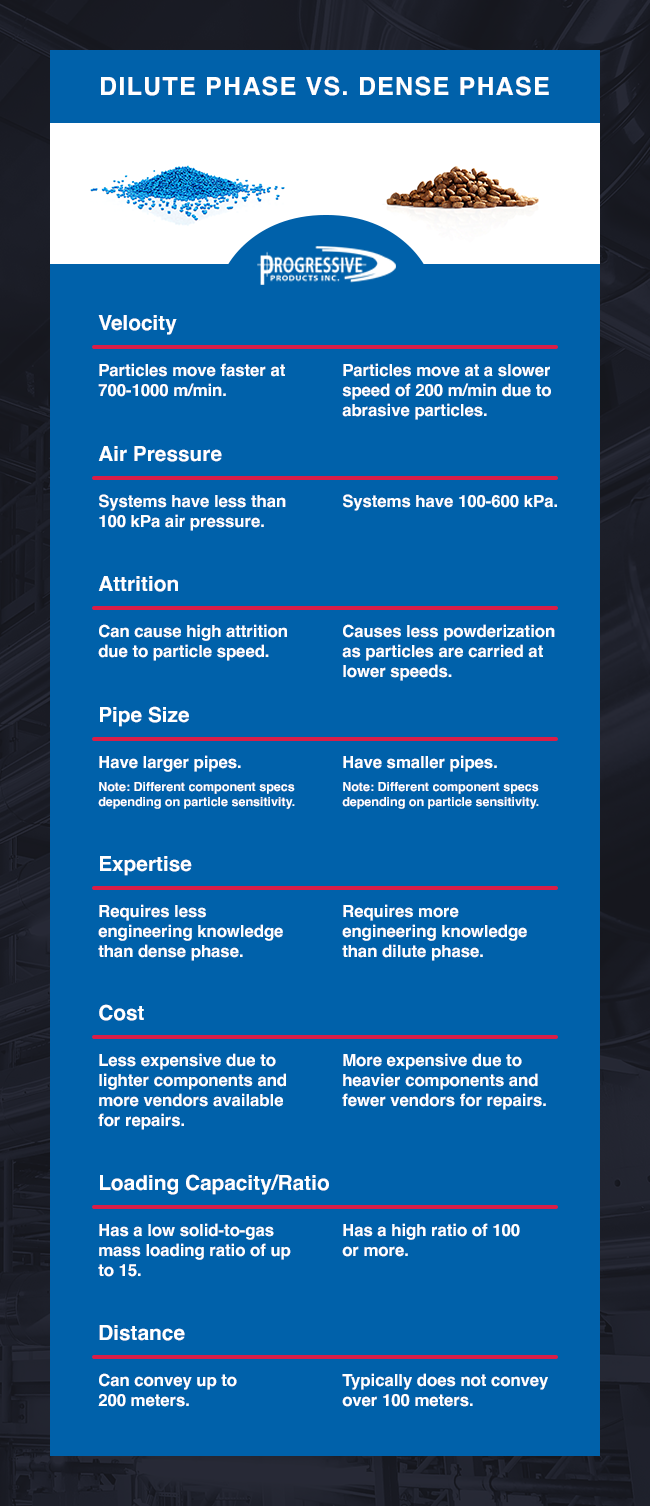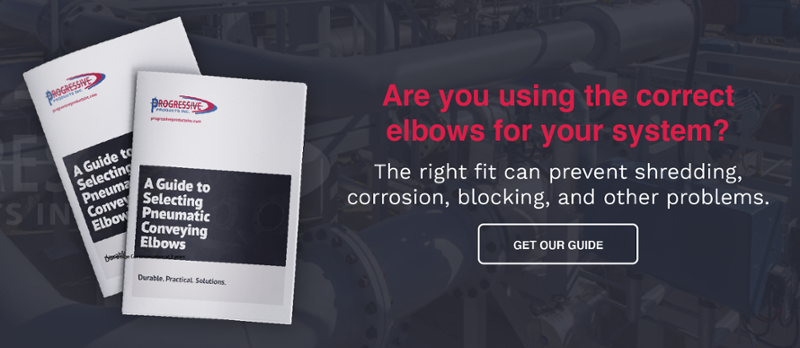Knowing the differences between dense phase conveying and dilute phase conveying (also called lean phase conveying), particularly in terms of fluid mechanics, will allow you to precisely design and calibrate your pneumatic conveying system.
If you’re a plant manager or plant engineer, you’ll know the importance of carefully calibrating the speed and pressure of air inside a pneumatic conveying system. The calibration will largely depend on the type of bulk material you’re conveying, and this is where the dense phase and dilute phase come in.

What Does Dense Phase Mean?
Dense phase conveying is still a relatively new concept in the industry, and so system designs are still held more close than with dilute phase conveying, which has been around much longer. (This also means it’s important to have the proper training and knowledge when you’re working on dense phase systems.)
As the name implies, dense phase conveying involves tightly packed bulk material particles, such as dog kibble, frozen veg, powders, and plastic pellets. In the dense phase, the product isn’t suspended in the air because it’s either too heavy or very abrasive.
The velocity of the air current is also kept high (100kPa or higher). This means the product travels in “waves”, “plugs” or “strands”, and creates less abrasion, so dense phase conveying is better for friable or delicate products that could break up during conveyance.
What Does Dilute Phase Mean?
Dilute phase conveying involves bulk material particles that are largely spaced out. These particles are lighter and are more abrasive. This means that the material can be conveyed at relatively faster velocities and higher pressures than in a dense phase. For instance, talcum powder is lighter and much less abrasive than something like plastic pellets, so it can be conveyed at higher velocities and air pressures because it causes less damage.
In dilute phase conveying, you use a blower to move product through the system by the air stream. The air stream needs to be just right in order to keep the product in the flow and prevent them from dragging on the bottom of the pipe or tube.
What About Lean Phase Conveying?
You’ll also hear dilute phase conveying referred to as lean phase conveying. You’ll typically find the term lean phase conveying being used when you’re discussing a conveying system being turned up or down. There’s also something called ‘dilute medium phase conveying’, which sits between lean phase and dense phase conveying and happens when you turn your system down.
8 Differences Between Dense Phase And Dilute Phase In Pneumatic Conveying
There are several differences between dense phase pneumatic conveying and lean phase pneumatic conveying. Some differences are inevitable because they’re inherent properties of the bulk material itself - for example, dilute phase conveying often handles lighter particles. Other differences are necessary measures that ensure the proper handling of materials, and prevent things like abrasion or powderization of particles.
Here are some major differences between dense phase conveying and the dilute phase conveying:
- Velocity: The velocity in dilute phase pneumatic conveying systems is usually faster compared to the dense phase, typically ranging between 700 and 1,000 m/min. The velocity of dense phase conveying is only about 200 m/min, given how abrasive the particles being carried are.
- Air pressure: The air pressure inside air ducts, tubes, and pipes of a dilute phase conveying system is relatively low compared to either lean phase conveying or dense phase pneumatic conveying. While the dilute phase has air pressure of less than 100 kPa, the dense phase has air pressure of 100kPa up to 600kPa.
- Attrition: Attrition refers to the breakage of powder. In a dilute phase, attrition can be very high because of the speed at which particles travel. It’s the opposite when it comes to dense phase pneumatic conveying because bulk materials in these systems are usually carried at lower speeds, making them less likely to powderize.
- Pipe size: The pipe sizes in dilute phase conveying systems tend to be larger than the pipe sizes in dense phase conveying systems. The various components used in these pneumatic conveying systems are also slightly different in terms of specifications because their optimal performance will depend on the particles being carried and how abrasive or sensitive they are.
- Expertise: Dense phase conveying requires certain levels of qualification from an engineer who is more knowledgeable than a dilute phase engineer may need to be.
- Cost: It’s typically more expensive to construct a dense phase conveying system mainly because of the specs of the components, which are relatively more heavy duty compared to a dilute phase system. Additionally, as dense phase conveying is still relatively new, there are fewer vendors to choose from and fewer go-to options if you need repairs. Indeed, if you see errors on your dense phase system, you may need to go back to the original designer or engineer for support.
- Loading capacity or ratio: Dilute phase pneumatic conveying systems have a low solid-to-gas mass loading ratio of up to 15. In comparison, a dense phase system has a very high solid-to-gas mass loading ratio of 100 or more.
- Distance: The maximum distance of conveyance also differs between dense phase conveying and dilute phase conveying: a dilute phase system has a conveyance distance of up to 200 meters, while a dense phase system typically does not convey over 100 meters.



